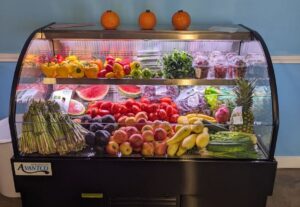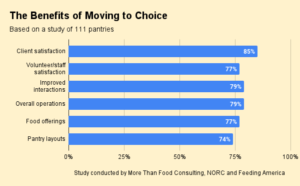Like many food pantry managers, the ones at Interfaith Food Pantry of the Oranges in New Jersey wanted their clients to be able to choose their foods, as if in a grocery store. But they also saw a lot of obstacles: they didn’t have a dedicated space for their pantry, requiring them to set it up and break it down for every distribution. Plus, they had very little room for storage.
Only after touring several other pantries did it click for Jodi Cooperman, Treasurer of IFPO, that the so-called “client-choice” model can exist in many different formats. “A lightbulb went off,” Cooperman said.
Client-choice came to IFPO three years ago as a series of manned tabletop stations, each offering clients a selection, such as grapes versus peaches, or pancake mix versus oatmeal. Clients wind their way through at least half a dozen of these pop-up stations, usually aided by a volunteer helper. It’s a big improvement over the pre-packaged bags IFPO used to hand out, which often resulted in clients receiving unwanted items.
“There’s a lot less waste” with client-choice, said Diane Stein, President of IFPO. “When we did bags, people sometimes left items in the parking lot.”
IFPO’s table-top approach is one of several models that space-constrained pantries are exploring as they increasingly embrace client-choice. Some pantries are letting clients peek through windows or half-doors into food storage rooms, and having them point and choose items directly from shelves, with volunteers filling the orders. Another approach is to have clients choose food from a list.
Whatever the model, the goal is to deliver greater dignity and higher satisfaction. Client-choice easily succeeds on both fronts. “We felt a change from the very first day,” Stein said. “There was so much gratitude.” Since client-choice went into effect, the number of clients coming to IFPO has increased dramatically, from 546 in July 2016, to almost 1300 in July 2019.

West Side Campaign Against Hunger, the originator of the client-choice model more than 25 years ago, is a case study in how a less-than-perfect space can still support client choice. Located in the basement of a church on the Upper West Side of Manhattan, WSCAH operates out of a warren of awkwardly shaped rooms.
In the “supermarket,” clients make a small loop around a modestly sized room, picking items off of dedicated shelving. They carry a card that provides instructions on how much of each item they should select, based on their household size. Unlike IFPO, in which volunteers aid clients as they shop, the WSCAH has a “check-out” station where volunteers assure clients took as much as they were allotted, and not too much. “The client-choice model in general instills more dignity,” noted Stephanie Moshier, Partnership and Outreach Manager at WSCAH.
Client choice does not necessarily involve more labor, especially given the work involved in making pre-packaged bags for clients to pick up. But some organizing and planning is involved. IFPO, for example, distributes paper slips upon check-in that indicate how much of each item a client is allowed to take, given the size of their household. The slips are color-coordinated, making it easy for the volunteer table-minders, who are known as “shopkeepers,” to see.
IFPO also put a lot of thought into how to accommodate different family sizes, ultimately deciding on three categories of household size: one person; two to three people, and four or more people. “We wanted to treat clients well, without encouraging overuse,” Cooperman explained.
When IFPO made the move to client choice, it did it all at once, without prepping clients ahead of time. It turns out that being able to select the food you like is a natural human tendency, helping to make the transition seamless. “It made more sense to have people just see it, live it, do it,” Cooperman said.
ABOVE: Jodi Cooperman, left, and Diane Stein at the Interfaith Food Pantry of the Oranges in New Jersey.










